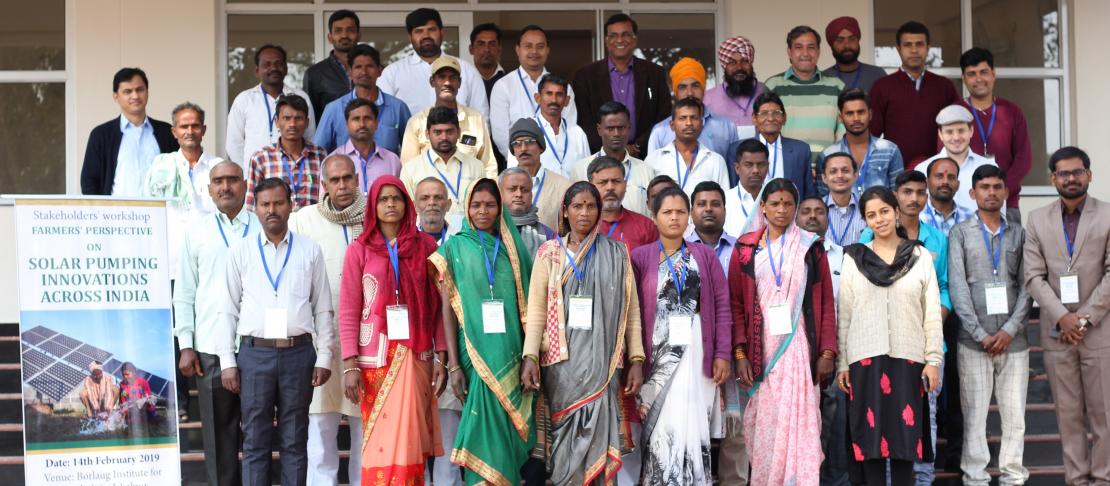Sunshine may pave the way towards a climate resilient future

A farmers’ stakeholder workshop was organized in Jabalpur, India, to discuss the factors impacting scaling out solar powered irrigation systems in India.
While India is facing its worst water crisis, solar pump users benefit from a steady water supply to their fields. Due to technological advancement, along with significant subsidies provided by the government, the number of solar pump users has been increasing. Yet, adoption of this technology at large scale seems to be a farfetched goal. In order to understand the end user’s point of view on solar powered irrigation systems (SPIS), a farmers' stakeholder workshop titled "Farmers’ Perspective on Solar Pumping Innovations Across India" was organized on 14 February 2019, at the research and development center of the Borlaug Institute for South Asia (BISA) in the district of Jabalpur, Madhya Pradesh, India.
The workshop was organized as part of the CGIAR Research Program on Climate Change, Agriculture and Food Security (CCAFS), by BISA and the International Maize and Wheat Improvement Center (CIMMYT), in collaboration with the Deutsche Gesellschaft für Internationale Zusammenarbeit GmbH (GIZ) and International Water Management Institute (IWMI). Farmers from six states of India participated in this workshop. The main objectives of the event were to:
- Triangulate the findings of the national survey on evaluating SPIS in India;
- Understand farmers’ perspectives on the scalability aspects of SPIS and
- Explore the possibility of SPIS market beyond the subsidy regime.
Participatory learning for researchers and farmers
The workshop began with an introductory note emphasizing the importance of using clean energy for sustainable development and how farmers play a key role in the transition from conventional to clean energy sources. Speakers presented findings that noted how the support and money provided by the government for installing solar pumps, combined with no operation and maintenance cost, created an economic incentive for farmers to have SPIS installed. A short presentation also gave an overview of various deployment approaches of SPIS, implemented across India.
After the presentations, the floor was opened for discussion to understand farmers’ views on these models and their scalability. Since most of the installations were made with the economic support of the government, provided in the form of a subsidy, a participatory exercise titled ‘Willingness to Pay” tried to explore the readiness of farmers to pay the entire capital cost for the installation of SPIS.
Farmers’ opinion on SPIS
A Strength, Weakness, Opportunity and Threats (SWOT) exercise helped the participants exchange ideas, understand each other’s point of view as well as understand how farmers perceive solar powered irrigation systems. Focus group discussion along with matrix ranking and scoring was used to delve into the attitude of farmers’ to adopt SPIS technology. During the discussion, an increase in farm production and thereby income appeared to be one of the most significant factors for farmers—who were either practicing rainfed agriculture or were dependent on diesel pumps—to install SPIS.
Installing a solar powered irrigation system on my field has significantly reduced my costs for water pumping. In addition to this saving, the steady water supply has increased my yields further adding to my annual income. To me, SPIS has been a blessing.”
Shivram Devu Kharpade, farmer from Maharashtra
On the other hand, high capital cost emerged as one of the major barriers to installing SPIS, followed by the fear of breakage and theft. Concern about the increased amount of time needed to irrigate fields due to less water discharge by solar pumps was also raised. Contemplating ways to further reduce the farmers’ share of the capital cost of solar pumps, farmers chose an increased amount of subsidy on clean technologies like solar pumps over other resources. While discussing sustainable usage of SPIS technology, groundwater depletion was raised as a concern by all the farmers. On a humorous note, they said “if there won’t be any groundwater, how will any of the pumping technology help us?” and touched upon one of the most critical factors that could impact the sustainable use of SPIS.
SPIS offers a climate-smart approach, which can enhance the adaptive capacity of the farmers while significantly curtailing greenhouse gas emissions. A significant capital subsidy, an expected increase in crop production along with reduced expenditure on pumping water will attract farmers to implement SPIS. However, a scaling program that is only promoting access to a free and regular supply of energy is not sustainable; it should offer a holistic solution, which integrates initiatives to ensure the availability of other resources as well.
Read more:
Sakshi Saini is Research Consultant for CCAFS South Asia. Paresh Shirsath is Associate Scientist for CCAFS South Asia.



